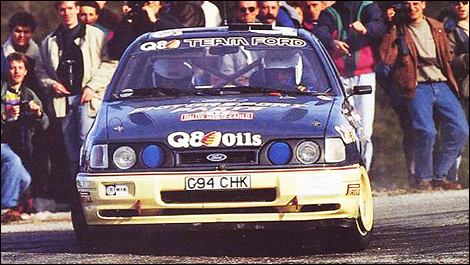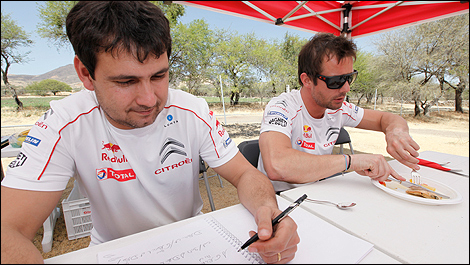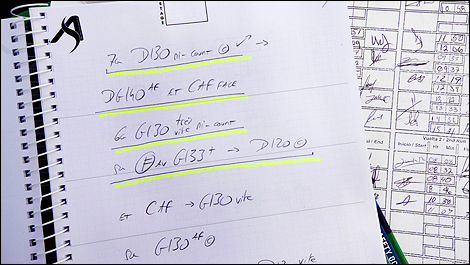Apr
9th
Stay connected Subscribe to our RSS feed
The author, Anne-Chantal Pauwels was Francois Delecour's co-driver in the ‘90s when they both were a Ford works' team in the World Rally Championship. She still attends several WRC events, and she explains here how the role of the co-driver has changed dramatically over the past 20 years.
Three days of competition instead of five, 300-400 kilometres of timed special instead of 600, two recce runs... WRC co-drivers have to march to the beat of a well-oiled machine these days. No more improvisation!
Technology has come a long way; co-drivers for instance are more efficient then when they had only a stop watch to work with. They did have to go on a diet though: the two men in the car can weigh no more than 160kg today.
Bottom line, the job of assisting a rally driver has changed over the last 20 years.
BEFORE THE RALLY
Maps are downloaded from the WRC's website. No more tracing lines and circling infinite towns on a map, which, with up to 38 stages on unlisted Portugal roads like we used to have was quite tricky.
How much time should you factor for service between stages? The answer is much less. In the old days, assistance crews had to travel thousands of kilometres in the middle of nowhere, having no GPS to guide us. Nowadays, mechanics are parked in dedicated "service areas" for the whole rally, and barely move over the course of an event.
VIDEO NOTES
Today, the two recce runs are filmed and thoroughly reviewed to iron out any mistake in the notes. In the 90s, when cameras weren't exactly what they are today, we drove up and down each stage as much as we wanted, at the wheel of an unmarked genuine rally car, sometimes up to 20 times.
DURING THE RALLY
Choosing tires between 20 compounds -- before each run! -- used to drive us nuts. How is the weather? How long is the stage? What's the surface like? Now, it's much easier. Today, 32 to 36 tires max are allowed; two compounds (soft or hard) for dirt, snow or tarmac, and only one tread pattern. It's not only cheaper, it's also simpler!
Technology has come a long way in helping out the men in the right seat. For starters, road-books have become so precise, they even include GPS coordinates! With mobile phones, co-drivers can relay feedback to the engineers minutes after the end of a stage. With the onboard computer they have access to "sector" times, and even get an idea of what their rivals are doing. Some cars are even equipped with satellite phone (Citroen DS3 and VW Polo WRC).
The days of waiting at the phone booth are definitely over...
Even though they're not out on their own out there, drivers and co-drivers don't have the physical help of mechanics between stages. Instead, they get trained, and change tires themselves between runs, and sometimes even adjust ride height.
Also over are the days of running 36-hour stages. In modern rallying, cars mostly run during the day and average lengths have dropped to 25 or even 15 kilometres. Numbers too have dropped: from 44 stages in Greece during the 90s, today rallies total about 12.
Meal plans are not what they used to be either. Every team member can now enjoy decent meals in the paddock.
Last but not least, punching in at a checkpoint can be done in the comfort of the car. With the exception of France, co-drivers don't have to get out of the car anymore. Instead, timekeepers come to you. Looking back, this one could actually be the biggest step forward in the world of rallying...
Three days of competition instead of five, 300-400 kilometres of timed special instead of 600, two recce runs... WRC co-drivers have to march to the beat of a well-oiled machine these days. No more improvisation!
 |
| François Delecour and Anne-Chantal Pauwels, Ford Sierra (Photo: Ford) |
Technology has come a long way; co-drivers for instance are more efficient then when they had only a stop watch to work with. They did have to go on a diet though: the two men in the car can weigh no more than 160kg today.
Bottom line, the job of assisting a rally driver has changed over the last 20 years.
BEFORE THE RALLY
Maps are downloaded from the WRC's website. No more tracing lines and circling infinite towns on a map, which, with up to 38 stages on unlisted Portugal roads like we used to have was quite tricky.
How much time should you factor for service between stages? The answer is much less. In the old days, assistance crews had to travel thousands of kilometres in the middle of nowhere, having no GPS to guide us. Nowadays, mechanics are parked in dedicated "service areas" for the whole rally, and barely move over the course of an event.
VIDEO NOTES
Today, the two recce runs are filmed and thoroughly reviewed to iron out any mistake in the notes. In the 90s, when cameras weren't exactly what they are today, we drove up and down each stage as much as we wanted, at the wheel of an unmarked genuine rally car, sometimes up to 20 times.
 |
| Daniel Elena, co-driver of Sebastien Loeb at Citroen. (Photo: Citroen Racing) |
DURING THE RALLY
Choosing tires between 20 compounds -- before each run! -- used to drive us nuts. How is the weather? How long is the stage? What's the surface like? Now, it's much easier. Today, 32 to 36 tires max are allowed; two compounds (soft or hard) for dirt, snow or tarmac, and only one tread pattern. It's not only cheaper, it's also simpler!
Technology has come a long way in helping out the men in the right seat. For starters, road-books have become so precise, they even include GPS coordinates! With mobile phones, co-drivers can relay feedback to the engineers minutes after the end of a stage. With the onboard computer they have access to "sector" times, and even get an idea of what their rivals are doing. Some cars are even equipped with satellite phone (Citroen DS3 and VW Polo WRC).
 |
| Some notes from Daniel Elena (Photo: Citroen Racing) |
The days of waiting at the phone booth are definitely over...
Even though they're not out on their own out there, drivers and co-drivers don't have the physical help of mechanics between stages. Instead, they get trained, and change tires themselves between runs, and sometimes even adjust ride height.
Also over are the days of running 36-hour stages. In modern rallying, cars mostly run during the day and average lengths have dropped to 25 or even 15 kilometres. Numbers too have dropped: from 44 stages in Greece during the 90s, today rallies total about 12.
Meal plans are not what they used to be either. Every team member can now enjoy decent meals in the paddock.
Last but not least, punching in at a checkpoint can be done in the comfort of the car. With the exception of France, co-drivers don't have to get out of the car anymore. Instead, timekeepers come to you. Looking back, this one could actually be the biggest step forward in the world of rallying...
 |
| Anne-Chantal Pauwels, co-driver Ford. (Photo: Archives Anne-Chantal Pauwels) |
 The latest auto news, reviews, prices, product and vehicle releases.
The latest auto news, reviews, prices, product and vehicle releases.